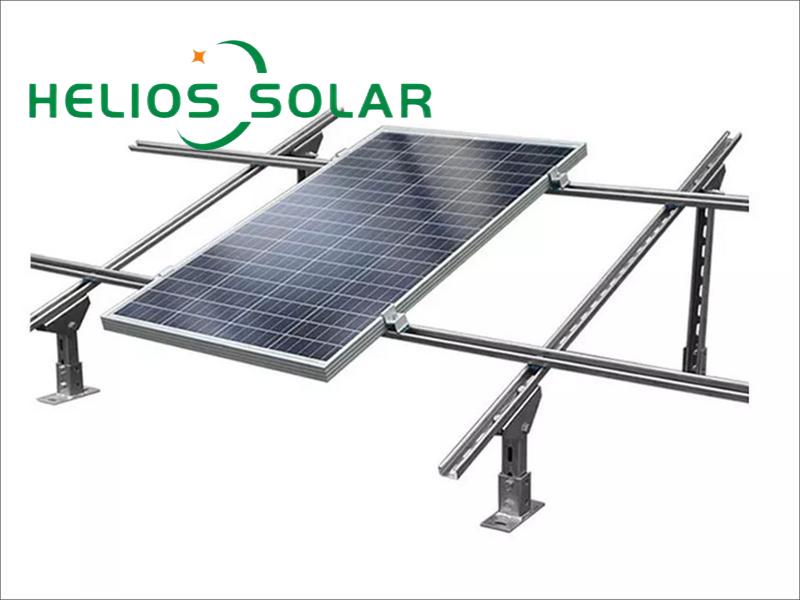Solar bracket is an indispensable supporting member in a solar power station. Its design scheme is related to the service life of the entire power station. The design scheme of the solar bracket is different in different regions, and there is a big difference between the flat ground and the mountainous situation. At the same time, the various parts of the support and accuracy of the bracket connectors are related to the ease of construction and installation, so what role do the components of the solar bracket play?
Solar bracket components
1) Front column: it supports the photovoltaic module, and the height is determined according to the minimum ground clearance of the photovoltaic module. It is directly embedded in the front support foundation during project implementation.
2) Rear column: It supports the photovoltaic module and adjusts the inclination angle. It is connected with different connection holes and positioning holes through connecting bolts to realize the change of the height of the rear outrigger; the lower rear outrigger is pre-embedded in the rear support foundation, Eliminate the use of connecting materials such as flanges and bolts, greatly reducing project investment and construction volume.
3) Diagonal brace: It acts as an auxiliary support for the photovoltaic module, increasing the stability, rigidity and strength of the solar bracket.
4) Inclined frame: the installation body of photovoltaic modules.
5) Connectors: U-shaped steel is used for front and rear columns, diagonal braces, and oblique frames. The connections between various parts are directly fixed by bolts, which eliminates the conventional flanges, reduces the use of bolts, and reduces investment and maintenance costs. construction volume. Bar-shaped holes are used for the connection between the oblique frame and the upper part of the rear outrigger, and the connection between the diagonal brace and the lower part of the rear outrigger. When adjusting the height of the rear outrigger, it is necessary to loosen the bolts at each connection part, so that the connection angle of the rear outrigger, front outrigger and the inclined frame can be changed; the displacement increment of the inclined brace and the inclined frame is realized through the strip hole .
6) Bracket foundation: The drilling concrete pouring method is adopted. In the actual project, the drill rod becomes longer and shakes. Satisfies the harsh environmental conditions of strong winds in Northwest China. In order to maximize the amount of solar radiation obtained by the photovoltaic module, the angle between the rear column and the inclined frame is roughly an acute angle. If it is a flat ground, the angle between the front and rear columns and the ground is roughly at right angles.
Solar bracket classification
The classification of solar bracket can be mainly distinguished according to the material and installation method of the solar bracket.
1. According to solar bracket material classification
According to the different materials used for the main load-bearing members of the solar bracket, it can be divided into aluminum alloy brackets, steel brackets and non-metallic brackets. Among them, non-metallic brackets are less used, while aluminum alloy brackets and steel brackets have their own characteristics.
| Aluminum alloy bracket | Steel frame | |
| Anti-corrosion properties | Generally, anodic oxidation (>15um) is used; aluminum can form a protective film in the air, and it will be used later No corrosion maintenance required |
Generally, hot-dip galvanizing (>65um) is used; anti-corrosion maintenance is required in later use |
| Mechanical strength | The deformation of aluminum alloy profiles is about 2.9 times that of steel | The strength of steel is about 1.5 times that of aluminum alloy |
| Material weight | About 2.71g/m² | About 7.85g/m² |
| Material price | The price of aluminum alloy profiles is about three times that of steel | |
| Applicable items | Household roof power stations with load-bearing requirements; industrial factory roof power stations with corrosion resistance requirements | Power stations that require strength in areas with strong winds and relatively large spans |
2. According to the solar bracket installation method classification
It can be mainly divided into fixed solar bracket and tracking solar bracket, and there are more detailed classifications corresponding to them.
| Photovoltaic bracket installation method | |||||
| Fixed photovoltaic support | Tracking photovoltaic support | ||||
| Best fixed tilt | sloped rooffixed | adjustable inclination fixed | Flat single axis tracking | Inclined single-axis tracking | Dual axis tracking |
| Flat roof, ground | Tile roof, light steel roof | Flat roof, ground | Ground | ||
If you are interested in solar brackets, welcome to contact solar bracket exporter Tianxiang to read more.
Post time: Mar-15-2023


